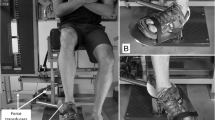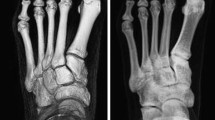Summary
In spite of the fact that discomfort from the subtalar area is common after varus-deformed tibial shaft fractures no plausible mechanism is to be found in the literature. A mechanical analysis of the problems shows that a varus deformity is compensated as pronation of the foot. A limited pronation capacity could thus be the cause of the pain. Pronation capacity was accurately measured in ten osteoligamentous preparations. The average pronation capacity was found to be 9.5° ± 7.0°. There was a marked interindividual variation. In two of the specimens the pronation capacity was less than 1°. Capacity decreased by 0.21° for every degree increase in plantar flexion of the ankle joint. Thus, a small pronation capacity may be the mechanical basis for ankle complaints after varus-deformed tibial shaft fractures. An anterior angulation, compensated as plantar flexion, further decreases the pronation capacity and adds to the risk associated with varus deformities.
Similar content being viewed by others
References
American Academy of Orthopedic Surgeons (1966) Joint motion. Livingstone, London
Fick R (1911) Handbuch der Anatomic und Mechanik der Gelenke, III. Gustav Fischer, Jena, p 621
Goldie I (1983) Ont i höft kna fot. (Pain in hip, knee, foot). PR-offset, Mölndal, p 44
Inman VT (1976) The joints of the ankle. Williams and Wilkins, Baltimore
Lanz TV, Wachsmutz W (1938) Praktische Anatomie, vol I, chap 4: Bein and Statik. Julius Springer, Berlin, pp 349–351
Larsson K (1983) Studies on tibial shaft fractures. Diss Acta Universitatis Upsaliensis 469, Reprocentrales HSC, Uppsala
McRae R (1976) Clinical orthopaedic examination, Churchill Livingstone, Edinburgh, p 191
Müller ME, Allgöwer M, Schneider R, Willenegger H (1977) Manual der Osteosynthese, 2. Auflage. Springer, Berlin Heidelberg New-York, p 254
Olerud C, Rosendahl Y (submitted for publication) The torsion-transmitting properties of the hindfoot. Clin Orthop
Viidik A, Lewin T (1966) Changes in tensile strength characteristics and histology of rabbit ligaments induced by different modes of postmortal storage. Acta Orthop Scand 37:141–155
Author information
Authors and Affiliations
Rights and permissions
About this article
Cite this article
Olerud, C. The pronation capacity of the foot —Its consequences for axial deformity after tibial shaft fractures. Arch. Orth. Traum. Surg. 104, 303–306 (1985). https://doi.org/10.1007/BF00435947
Received:
Issue Date:
DOI: https://doi.org/10.1007/BF00435947




